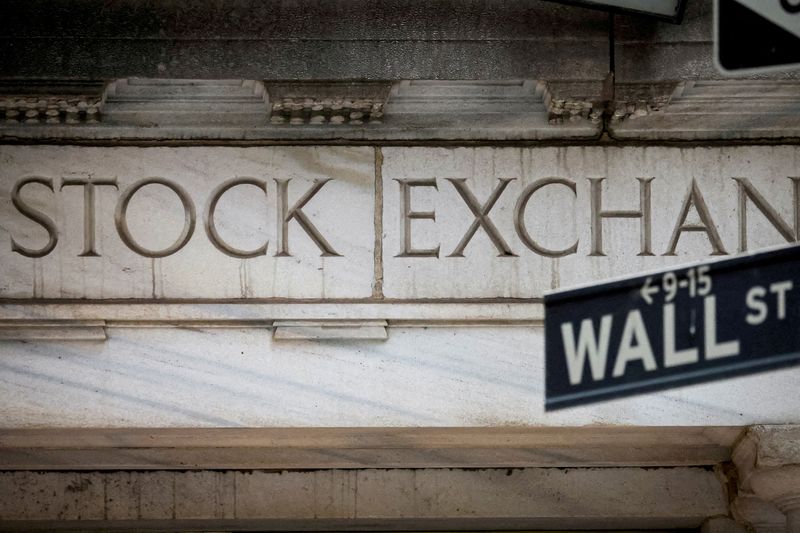A look at the day ahead in U.S. and global markets from Mike Dolan
With markets now re-shuffling central bank rate cut calendars, attention switches abruptly to the first quarter U.S. corporate earnings season on Friday – against a backdrop of an alarming swoon in China trade last month and rising Middle East tension.
As usual, the big U.S. banks are first out of the traps and are preparing to report slightly lower quarterly profits – even if investors may focus on this year’s interest income outlook given the rethink on the Federal Reserve’s policy trajectory.
JPMorgan, Citi, Wells Fargo, State Street (NYSE:), BlackRock (NYSE:) are all due to report later today.
More broadly, technology-related company earnings are expected to again lead profit growth during the first three months – although the forecast annual earnings expansion of 5% for the index is about two points lower than it was at the start of the year.
And it was Big Tech yet again – spurred by a surge in Apple shares (NASDAQ:) on a report it plans to overhaul all its Mac models with AI-focused chips – which led Thursday’s Wall St bounceback. It was more bumpy for earnings-focussed banks – with Morgan Stanley slumping 5% on a Wall Street Journal report that its wealth management arm is being probed by multiple regulators.
But clocking a 0.7% rebound in the S&P500, the general market mood improved considerably after Wednesday’s inflation-related shakeout. Softer U.S. producer price readings for March – including in key components that feed the Fed’s favoured PCE inflation gauge – were a big relief to interest rate markets.
And even though Fed officials were clearly cautious about the stickiness in the prior day’s consumer price data, they didn’t seem minded to redraw the whole policy map just yet.
“There’s no clear need to adjust monetary policy in the very near term,” New York Fed boss John Williams told reporters.
Fed futures re-calibrated again, pushing back closer to pricing two rate cuts this year – starting in September just six weeks before the U.S election. While a June start is now off the agenda, the chance of a move as soon as July moved back above 50%.
The easier producer price numbers and Fed speakers were also enough to drag Treasury yield back off the year’s highs – with two-year yields recoiling from 5% to settle just over 4.90% first thing on Friday.
Rising tension surrounding an imminent Iranian response Israel’s attack on its Syrian embassy may have added a safety bid to bonds ahead of the weekend. Gold, which has now risen 17% in just six weeks, hit another record high of $2,400 early on Friday and oil ticked back above $86 per barrel.
The dollar too was pumped up – with its index hitting another 2024 high.
But the buck is gaining as much on the shift in central bank sequencing – with the European Central Bank indicating on Thursday that it may well go ahead and cut rates in June regardless of Fed hesitation.
Confirmation that German inflation sank to its lowest in almost three years at just 2.3% last month underlined expectations that the ECB will go solo by midyear.
German two-year government debt yields fell back 10 basis points and European stocks jumped 1% on Friday as a result.
But the euro plunged to its lowest of the year, clocking its biggest 3-day drop in 14 months.
The dollar was also bolstered by ongoing Japanese yen weakness to 34-year lows and the shocking Chinese trade data that hit the yuan.
China’s March exports contracted sharply, while imports also unexpectedly shrank, both undershooting market forecasts by big margins. Shipments from China slumped 7.5% year-on-year last month, marking the biggest fall since August last year and compared with a 2.3% decline forecast in a Reuters poll of economists.
Chinese stocks ended the week in the red as a result.
Even though sterling also fell back to a one-month low against the dollar, markets are less sure the Bank of England will be as bold as the ECB in cutting rates as soon as June. Money markets price less than a 50% chance of a BOE move that month.
What’s more, Britain’s tepid economy is on course to exit a shallow recession after output grew for a second month in a row in February and January’s reading was revised higher.
And former Federal Reserve Chair Ben Bernanke will set out on Friday how the Bank of England should reform its economic forecasting.
Key diary items that may provide direction to U.S. markets later on Friday:
* US corporate earnings: JPMorgan, Citi, Wells Fargo, State Street, BlackRock
* US March export and import prices, University of Michigan’s early April household survey
* Kansas City Federal Reserve President Jeffrey Schmid, Atlanta Fed President Raphael Bostic and San Francisco Fed chief Mary Daly all speak

* Bank of England publishes former Fed chair Ben Bernanke’s review of its forecasting methods
* ECOFIN meeting of European Union finance ministers in Luxembourg
(By Mike Dolan, editing by Andrew Heavens mike.dolan@thomsonreuters.com)

